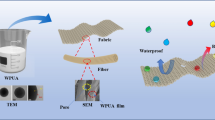Abstract
Double bond end-capped waterborne polyurethane (DWPU) was synthesized from toluene diisocyanate, hydroxypropyl polysiloxane, trimethylolpropane, N-methyldiethanolamine, and hydroxyethyl acrylate. Then water repellents with long-chain hydrophobic alkyl structure were obtained by radical copolymerization of stearyl acrylate (SA) and DWPU. The waterproofing performance and other properties of the water repellents were studied for different SA contents. The results showed that, for the water repellent with SA content of 50 wt%, the water absorption of the film reduced to 4.29% while the water contact angle of fabric coated by the water repellent rose to 141.5°. In addition, the optimum SA content of the water repellent was 40%, achieving the highest score of 85 points in the waterproof performance evaluation.








Similar content being viewed by others
References
Kim, BK, Lee, JC, “Waterborne Polyurethanes and Their Properties.” Polym. Sci. A Polym. Chem., 34 (6) 1095–1104 (1996)
Fang, ZH, Duan, HY, Zhang, ZH, Wang, J, Li, DQ, Huang, YX, Shang, JJ, Liu, ZY, “Novel Heat-Resistance UV Curable Waterborne Polyurethane Coatings Modified by Melamine.” Appl. Surf. Sci., 257 (11) 4765–4768 (2011)
García-Pacios, V, Costa, V, Colera, M, Martín-Martínez, JM, “Waterborne Polyurethane Dispersions Obtained with Polycarbonate of Hexanediol Intended for Use as Coatings.” Prog. Org. Coat., 71 (2) 136–146 (2011)
Meng, QB, Lee, SI, Nah, C, Lee, YS, “Preparation of Waterborne Polyurethanes Using an Amphiphilic Diol for Breathable Waterproof Textile Coatings.” Prog. Org. Coat., 66 (4) 382–386 (2009)
Baillie, AE, Warner, SB, Fan, QG, “UV-Curable Coatings for Textiles: Water Repellent Finishes.” AATCC Rev., 5 (11) 35–39 (2005)
Gowri, S, Almeida, L, Amorim, T, Carneiro, N, Souto, AP, Esteves, MF, “Polymer Nanocomposites for Multifunctional Finishing of Textiles—A Review.” Text. Res. J., 80 (13) 1290–1306 (2010)
Gashti, MP, “Nanocomposite Coatings: State of the Art Approach in Textile Finishing.” J. Text. Sci. Eng., 4 e120 (2014)
Schultz, MM, Barofsky, DF, Field, JA, “Fluorinated Alkyl Surfactants.” Environ. Eng. Sci, 20 (5) 487–501 (2003)
Hu, Y, Kurogi, K, Tsujii, K, “High Oil-Repellent Poly(Alkylpyrrole) Films Coated with Fluorinated Alkylsilane by a Facile Way.” Colloids Surf. A, 292 (1) 27–31 (2007)
Mahltig, B, Bottcher, H, “Modified Silica Sol Coatings for Water-Repellent Textiles.” Sol Gel Sci. Technol., 27 (1) 43–52 (2003)
Stanssens, D, Abbeele, HVD, Vonck, L, Schoukensb, G, Deconinckb, M, Samynb, P, “Creating Water-Repellent and Super-Hydrophobic Cellulose Substrates by Deposition of Organic Nanoparticles.” Mater. Lett., 65 (12) 1781–1784 (2011)
Tragoonwichian, S, Kothary, P, Siriviriyanun, A, O’Rear, EA, Yanumet, N, “Silicon-Compound Coating for Preparation of Water Repellent Cotton Fabric by Admicellar Polymerization.” Colloids Surf. A, 384 (1) 381–387 (2011)
Ge, Z, Luo, Y, “Synthesis and Characterization of Siloxane-Modified Two-Component Water-Borne Polyurethane.” Prog. Org. Coat., 76 (11) 1522–1526 (2013)
Zhang, HW, Du, M, Wang, N, Zheng, Q, “Study on the Water Repellent Silicone-Polyurethane Block Copolymers.” Acta Polym. Sin., 1 63–69 (2013)
Gashti, MP, Elahi, A, Gashti, MP, “UV Radiation Inducing Succinic Acid/Silica–Kaolinite Network on Cellulose Fiber to Improve the Functionality.” Compos. B Eng., 48 (5) 158–166 (2013)
Gashti, MP, Pournaserani, A, Ehsani, H, “Surface Oxidation of Cellulose by Ozone-Gas in a Vacuum Cylinder to Improve the Functionality of Fluoromonomer.” Vacuum, 91 (9) 7–13 (2013)
Noralian, Z, Gashti, MP, Ebrahimi, I, “Fabrication of a Multifunctional Graphene/Polyvinylphosphonic Acid/Cotton Nanocomposite via Facile Spray Layer-by-Layer Assembly.” RSC Adv., 6 (28) 23288–232999 (2016)
Fei, Y, Li, CX, Lin, MZ, Li, ZY, Yu, T, “Preparation of Octadecyl Acrylate/Vinyl Acetate Copolymer and Its Pour Point Depression Functions for Waxy Crude Oils.” Oilfield Chem., 26 (1) 102–105 (2009)
Gashti, MP, Alimohammadi, F, Shamei, A, “Preparation of Water-Repellent Cellulose Fibers Using a Polycarboxylic Acid/Hydrophobic Silica Nanocomposite Coating.” Surf. Coat. Technol., 206 (14) 3208–3215 (2012)
Zahid, M, Heredia-Guerrero, JA, Athanassiou, A, Bayer, IS, “Robust Water Repellent Treatment for Woven Cotton Fabrics with Eco-Friendly Polymers.” Chem. Eng. J., 319 321–332 (2017)
Sun, DY, “The Synthesis and Research of Octadecyl Acrylate Modified Silicone.” Silicone Mater., 26 (3) 153–156 (2012)
Yang, H, The Preparation of Hydrophobic Breathable Fabric Based on the Reactivity of Long-Chain Acrylate Emulsion. Tianjin University, Tianjin, 2013
Hirose, M, Zhou, J, Nagai, K, “The Structure and Properties of Acrylic-Polyurethane Hybrid Emulsions.” Prog. Org. Coat., 38 (1) 27–34 (2000)
Zhang, C, Zhang, X, Dai, J, Bai, C, “Synthesis and Properties of PDMS Modified Waterborne Polyurethane–Acrylic Hybrid Emulsion by Solvent-Free Method.” Prog. Org. Coat., 63 (2) 238–244 (2008)
Fei, L, “Synthesis and Properties of Acrylate Modified Waterborne Polyurethane Emulsion.” Paint Coat. Ind., 535–537 1386–1392 (2010)
Peruzzo, PJ, Anbinder, PS, Pardini, OR, Vega, J, Costa, CA, Galembeck, F, Amalvy, JI, “Waterborne Polyurethane/Acrylate: Comparison of Hybrid and Blend Systems.” Prog. Org. Coat., 72 (3) 429–437 (2011)
Ma, L, Song, L, Li, F, Wang, H, Liu, B, “Preparation and Properties of Poly (Propylene Carbonate)-Based Waterborne Polyurethane-Acrylate Composite Emulsion.” Colloid Polym. Sci., 295 (12) 2299–2307 (2017)
Busscher, HJ, Pelt, AWJV, Jong, HPD, Arends, J, “Effect of Spreading Pressure on Surface Free Energy Determinations by Means of Contact Angle Measurements.” Colloid Interface Sci., 95 (1) 23–27 (1983)
Higgins, SH, “Year Book of the American Association of Textile Chemists and Colorists, pp. 165. New York, 1924.” J. Chem. Technol. Biotechnol., 43 (40) 993–993 (2010)
Author information
Authors and Affiliations
Corresponding authors
Rights and permissions
About this article
Cite this article
Sheng, L., Zhang, X., Ge, Z. et al. Preparation and properties of waterborne polyurethane modified by stearyl acrylate for water repellents. J Coat Technol Res 15, 1283–1292 (2018). https://doi.org/10.1007/s11998-018-0096-x
Published:
Issue Date:
DOI: https://doi.org/10.1007/s11998-018-0096-x




